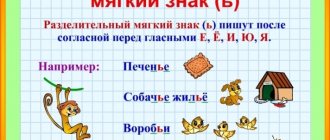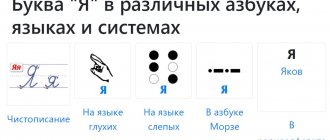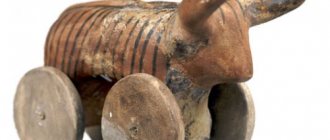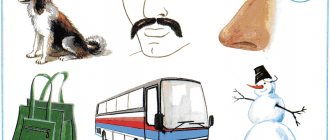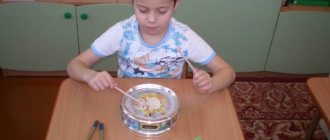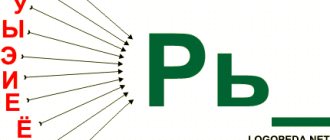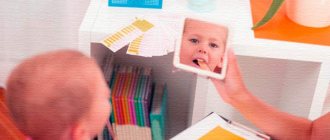Automation of sound
Exercises for automating the sound S: isolated, in syllables, words and sentences.
Automation of the sound of Sya begins with the easiest tasks for the baby.
Sing the “water song.” Say the sound Sya with a smile for a long time, on one exhalation: s-s-s-s...
Repeat straight syllables:
s-s-s-s-s-s-s-s.
Repeat the reverse syllables:
as-os-us-us-is-es-es-es-es-es.
Repeat the syllables where the sound S is between the vowels.
asi-ase-ase-asyu-asya usi-use-use-usyu-usya isi-ise-ise-isyu-isya axis-ose-ose-osyu-osya ysi-yse-yse-ysyu-ysia
Repeat straight syllables with consonant clusters.
sti-ste-sty-stu-sty sleep-spe-spy-spy-spy smi-sme-smo-smy-smy ski-ske-sko-sku-skya snya-sne-sno-snu-snya swee-swe-swe -syu-sya
Repeat the words where the sound S is at the beginning of the word.
Si: Sima, Simone, blue, sitting, sieve, siphon, blue, bruise, radiance, sitting, symphony, shine, blue, turn blue. Behold: hay, seven, family, seed, sowing, Senya, Seva, network, networks, sow, canopy, net, seeds, gray-haired, today, second, sow, family. Sho: Shoma, salmon. Su: suite, here. Xia: sit down, there and there. Confluence of consonants: poems, back, sleeps, snapshot, pig, pig, pork, pig breeder, retinue, wall, wall, flow, Stepan, steppe, snow, snowman, snowfall, laughter, change, sour cream, light, Sveta, shine, scheme , take off.
Repeat the words where the sound S is in the middle of the word.
Asya: Vaska.
Axle: string bag, pug, eighth.
Si: taxi, aspen, aspen, axes, spout, wear, geese, mow, Maxim, boletus, doggie, antennae, barefoot, Osip, bead, bead.
Is: letter.
Behold: autumn, eight, ash, song, songbook, Vasenka, insect, gazebo, hen, cassette, fidget, muslin, pouch, pool, hang.
Yes: braid.
Sho: that's it, ribbon.
Xiu: everywhere.
Sya: Asya, Vasya, goslings, Tosya, joint, oatmeal, ten, grandfather, grandmother, ten, carry, mow, knead.
Repeat the words where the sound S is at the end of the word.
Axis: axis, maybe.
Us: goose.
Ys: heights.
Is: inscription, signature, bend over. Yes: all.
Yus: I’m afraid, I wash myself, I wash myself, I get dressed, I get up.
Repeat words with two S sounds.
Sit down, seventy, lisp, demolish, mixture, laugh, whistle.
Repeat the phrases.
the goose family the eighth house blue ribbon crumpled fabric new suit
blue pouch thin aspen gray-haired grandfather aspen arbor blue bead
autumn day spring sowing steppe geese seven carriages school of geese
Repeat the proverb.
If only this laughter would be for everyone.
Repeat the sentences.
Three words: Asya washes the sieve. Maxim sows seeds. The dog eats sausages. The goose has goslings. Vasya is herding geese. Senya is carrying a letter. The aspen has boletus. Seva sings a song. Pigs eat oatmeal. Maxim walks barefoot.
Four words: Senya blows the whistle. Vasya is on the bus. The pig is sleeping on the hay. Grandma has ten geese. Asya has her mother's cassettes. Goslings are sitting on the hay. There is an inscription on Vasya's cassette. The light shines on the wall. Vasenka the cat is rolling beads. A sieve hangs on the wall. Senya's cat has a mustache. Grandpa has a blue pouch. The pug is sitting in the snow. There are seven sausages in the package. Grandma is sitting under an aspen tree.
Five words. The cat Vaska is sitting on an aspen tree. Today Seva is coming to visit. Asya's window has thin aspen. Vasya the cat walks through the snow. Asya brings home an autumn bouquet. My family is sitting in the gazebo.
Six words. Semyon has a lot of salmon in his nets. Asya and Tosya are traveling in a taxi. A hen sits in the entryway against the wall. Gray-haired grandfather Semyon has a lot of seeds.
Seven words. Neighbor Vasya goes to visit Maxim.
(based on the book by E. N. Spivak, automation of sound S)
How to distinguish between sounds and letters?
It is easy to distinguish between these concepts. We write down letters, draw them, see them. They look like this: A, e, p, U, M, b. Letters are needed to translate spoken language into written language. We speak, sing, and hear sounds. They are written in square brackets: [p] [o] [l]. This recording is called transcription.
Are the number of sounds and letters the same in the Russian language?
The Russian language has 33 letters and 42 sounds.
There are much more sounds, because not every sound corresponds to a letter. The same letter can convey different sounds. Yes, the letter r
in the words
blow
and
blow
defines different sounds: hard
[r]
and soft
[r'].
On what basis are speech sounds divided?
Speech sounds are divided into vowels and consonants according to the degree of use of voice in them. When forming vowel sounds, air passes through the mouth freely. The oral cavity opens wide. Only the voice is heard.
When pronouncing consonant sounds, the air in the mouth encounters obstacles: tongue, palate, teeth, lips. For example, to pronounce [b], [p], you need to clench your lips more closely, and the sounds [v], [f] are pronounced through the gap between the teeth and lips. Every consonant sound has noise.
Game “Where does the sound live: at the beginning, in the middle, at the end of the word?”
WHERE DOES THE SOUND L LIVE?
Determine the position of the sound in the word: at the beginning, in the middle, at the end.
Fill in the corresponding circle under the picture.
WHERE DOES THE SOUND L LIVE?
Determine the position of the sound in the word: at the beginning, in the middle, at the end.
Fill in the corresponding circle under the picture.
WHERE DOES THE SOUND L LIVE?
Determine the position of the sound in the word: at the beginning, in the middle, at the end.
Fill in the corresponding circle under the picture.
WHERE DOES THE SOUND L LIVE?
Determine the position of the sound in the word: at the beginning, in the middle, at the end.
Fill in the corresponding circle under the picture.
WHERE DOES THE SOUND R' LIVE?
Determine the position of the sound in the word: at the beginning, in the middle, at the end.
Fill in the corresponding circle under the picture.
WHERE DOES THE SOUND R' LIVE?
Determine the position of the sound in the word: at the beginning, in the middle, at the end.
Fill in the corresponding circle under the picture.
WHERE DOES THE SOUND R LIVE?
Determine the position of the sound in the word: at the beginning, in the middle, at the end.
Fill in the corresponding circle under the picture.
WHERE DOES THE SOUND R LIVE?
Determine the position of the sound in the word: at the beginning, in the middle, at the end.
Fill in the corresponding circle under the picture.
WHERE DOES THE SOUND LIVE ?
Determine the position of the sound in the word: at the beginning, in the middle, at the end.
Fill in the corresponding circle under the picture.
WHERE DOES THE SOUND LIVE ?
Determine the position of the sound in the word: at the beginning, in the middle, at the end.
Fill in the corresponding circle under the picture.
WHERE DOES THE SOUND F LIVE ?
Determine the position of the sound in the word: at the beginning, in the middle, at the end.
Fill in the corresponding circle under the picture.
WHERE DOES THE SOUND F LIVE ?
Determine the position of the sound in the word: at the beginning, in the middle, at the end.
Fill in the corresponding circle under the picture.
WHERE DOES THE SOUND C LIVE?
Determine the position of the sound in the word: at the beginning, in the middle, at the end.
Fill in the corresponding circle under the picture.
WHERE DOES THE SOUND C LIVE?
Determine the position of the sound in the word: at the beginning, in the middle, at the end.
Fill in the corresponding circle under the picture.
WHERE DOES THE SOUND Z LIVE?
Determine the position of the sound in the word: at the beginning, in the middle, at the end.
Fill in the corresponding circle under the picture.
WHERE DOES THE SOUND Z LIVE?
Determine the position of the sound in the word: at the beginning, in the middle, at the end.
Fill in the corresponding circle under the picture.
WHERE DOES THE SOUND T LIVE?
Determine the position of the sound in the word: at the beginning, in the middle, at the end.
Fill in the corresponding circle under the picture.
WHERE DOES THE SOUND T LIVE?
Determine the position of the sound in the word: at the beginning, in the middle, at the end.
Fill in the corresponding circle under the picture.
WHERE DOES THE SOUND H LIVE?
Determine the position of the sound in the word: at the beginning, in the middle, at the end.
Fill in the corresponding circle under the picture.
WHERE DOES THE SOUND H LIVE?
Determine the position of the sound in the word: at the beginning, in the middle, at the end.
Fill in the corresponding circle under the picture.
WHERE DOES THE SOUND LIVE ?
Determine the position of the sound in the word: at the beginning, in the middle, at the end.
Fill in the corresponding circle under the picture.
Vowel sounds and letters
There are six vowel sounds in Russian:
[a], [o], [y], [e], [i], [s].
In writing, sounds are represented by ten vowel letters:
a, i, e, e, o, u, s, e, yu, i.
For example:
- [a] – a (March) and I (mint)
- [and] – and (cinema)
- [s] – s (mouse)
- [o] – o (walrus) and e (aunt)
- [e] – e (echo) and e (accuracy)
- [y] – y (hoopoe) and yu (humor).
The ten vowel letters are easy to remember in pairs.
What is special about e, e, yu, i?
The four iotized letters e, e, yu, i stand out among others by two abilities:
- influence the preceding consonant, making it soft: to love - [l'u]beat.
- breaks down into two sounds:
| I | [y'a] |
| E | [y'e] |
| Yo | [y'o] |
| YU | [y'u] |
In transcription (in the designation of sounds) the letters e, e, yu, i are not used. They were excluded from the soundtrack.
In what cases do iotated vowels split into two sounds?
The letters e, e, yu, i represent two sounds:
- if the words appear at the beginning: amber - [y'i] amber,
- after a vowel: lightning – lightning[y'a],
- after ь and ъ signs: shrink - shrink.
Why can vowel sounds be strong and weak?
The power of vowel sounds is given by a special place in a word - stress. Under stress, the sound is pronounced clearly: wolf, park, forest, table.
Weakens the vowel - unstressed position. Thus, vowels lose their strength and change in the words five - p[i]terka, diaper - p[i]lenka, since the sound [i] is unstressed.
The vowel sound is part of the structure of the syllable, for this reason there are as many syllables in a word as there are vowel sounds.
Phonetic analysis of the word
Why do you need phonetic analysis of a word?
Phonetic analysis gives the sound characteristics of a word.
With its help, you can break down a word into letters and sounds. Match the number of letters and sounds. And find out the discrepancies between letters and sounds, if any.
What is the order of phonetic parsing?
Phonetic analysis is carried out in the following sequence.
- Indicate the number of syllables and indicate stress.
- Count the number of sounds and letters in a word.
- Describe vowel sounds: stressed/unstressed.
- Describe consonant sounds: voiced/voiceless, hard/soft.
